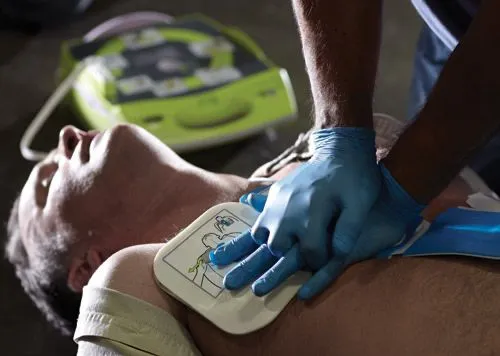Defibrillators in Healthcare: Types, Uses & Buying Guide

This comprehensive guide explains how defibrillators in healthcare work, what types exist (AED, manual, wearable), the safety and compliance essentials you must meet, and a buyer’s checklist to help hospitals and clinics select the right device with confidence.
What Is a Defibrillator?
A defibrillator is a medical device that delivers a controlled electrical shock to the heart to terminate life-threatening arrhythmias—primarily ventricular fibrillation (VF) and pulseless ventricular tachycardia (pVT). In simple terms, it “resets” chaotic electrical activity so that the heart’s natural pacemaker can resume an organized rhythm.
Modern hospitals use:
-
Automated External Defibrillators (AEDs) for quick action by trained or even lay responders.
-
Manual defibrillators with advanced features for clinicians.
-
Wearable and implantable devices for patients at chronic risk outside of acute care settings.
How Defibrillation Works in the Body
During VF, the ventricles quiver ineffectively due to disorganized electrical signals. Defibrillation delivers a high-energy shock across the myocardium to depolarize cardiac cells simultaneously, allowing the sinoatrial node to restore normal rhythm.
Modern devices use biphasic waveforms, which require less energy than older monophasic shocks, improving both success rates and patient safety. Pad placement (sternal–apical or anterior–posterior) also plays a crucial role in shock effectiveness.
Types of Defibrillators
1. Automated External Defibrillators (AEDs)
-
Users: Lay responders, hospital staff, public facilities
-
Energy: 120–200 J biphasic
-
Features: Voice/visual prompts, shock advisory, CPR coaching, pediatric mode
-
Best for: Public spaces, clinics, outpatient facilities
2. Manual Defibrillators
-
Users: Clinicians in ICU, OR, ER
-
Energy: 200–360 J (user-selected)
-
Features: ECG monitoring, sync mode, pacing, event recording
-
Best for: Hospitals and surgical environments
3. Wearable Cardioverter-Defibrillators (WCDs)
-
Users: High-risk patients at home
-
Features: Continuous ECG sensing, automatic therapy, remote data monitoring
4. Implantable Cardioverter-Defibrillators (ICDs)
-
Users: Chronic cardiac patients
-
Features: Long-term monitoring, antitachycardia pacing, automatic shocks
AEDs for Medical Centers & Public Areas
AEDs have transformed survival rates in sudden cardiac arrest. In hospitals, they complement crash carts and are often placed in non-critical wards where staff may lack advanced resuscitation training.
Hospitals typically deploy AEDs in:
-
Lobbies and waiting rooms
-
Dialysis centers
-
Radiology departments
-
Outpatient clinics
Manual Defibrillators in Hospitals
Manual defibrillators remain the gold standard for advanced resuscitation. They allow clinicians to:
-
Select shock energy levels
-
Perform synchronized cardioversion
-
Provide pacing when needed
-
Monitor ECG and vital parameters
These devices are critical in emergency departments, intensive care units, and operating rooms.
Wearable & Implantable Defibrillators
-
WCDs: Temporary protection for patients awaiting ICD implantation.
-
ICDs: Implanted permanently in patients with recurrent risk of arrhythmias.
While not purchased by hospitals in bulk, facilities should understand them for post-discharge continuity of care.
Safety, Compliance & Training Essentials
Hospitals must ensure:
-
Devices are FDA approved / CE marked.
-
Staff are trained in CPR and device use.
-
Pediatric pads are available where children are treated.
-
Regular drills are conducted to ensure readiness.
Defibrillator Buying Guide & Checklist
Key criteria for hospitals and clinics:
-
Device type (AED vs. manual)
-
Biphasic waveform technology
-
Pediatric capability
-
Connectivity (data export to EMR)
-
Battery life & charging cycles
-
Service and maintenance support
-
Warranty and spare part availability
-
Compliance with AHA/ERC guidelines
Installation, Training & Go-Live
-
Install AEDs in high-traffic areas.
-
Create clear signage and floor maps.
-
Conduct training sessions and code simulations.
-
Integrate devices into the hospital’s resuscitation protocols.
Maintenance, PM Schedules & Asset Lifecycle
-
AED pads and batteries expire every 2–5 years.
-
Manual defibrillators need annual preventive maintenance.
-
Hospitals should maintain an asset lifecycle plan with biomedical engineering oversight.
Troubleshooting & Common Issues
-
Battery failure: keep spare batteries.
-
Pad adhesion issues: check stock rotation.
-
Software errors: update firmware regularly.
Budgeting & Procurement Tips
-
Calculate Total Cost of Ownership (TCO) including consumables.
-
Consider leasing options for smaller clinics.
-
Bundle defibrillators with CPR training packages.
Connectivity & Data Integration
Modern devices integrate with:
-
Electronic Health Records (EHR)
-
Hospital monitoring systems
-
Cloud-based data storage for QA and audits
This improves documentation and supports quality metrics in resuscitation programs.
FAQs
Q1: How often should hospitals replace defibrillators?
Most hospitals replace them every 7–10 years, depending on usage and service contracts.
Q2: Can one AED serve both adults and children?
Yes, with pediatric pads or key, the same AED can treat children safely.
Q3: Are manual defibrillators mandatory in every hospital?
Yes. Hospitals must maintain at least one manual defibrillator per emergency/critical care unit.
Q4: Do defibrillators require internet connectivity?
No, but connected models provide valuable data integration and remote monitoring features.


